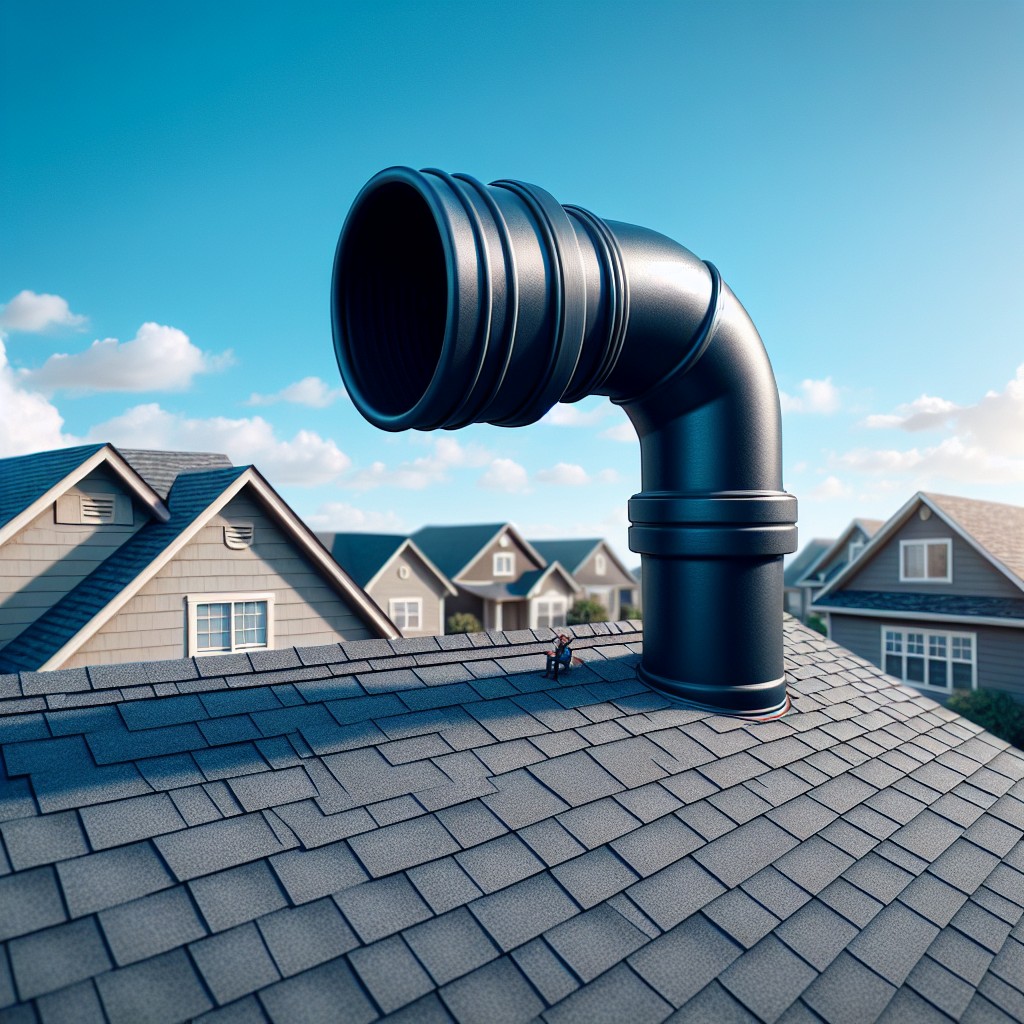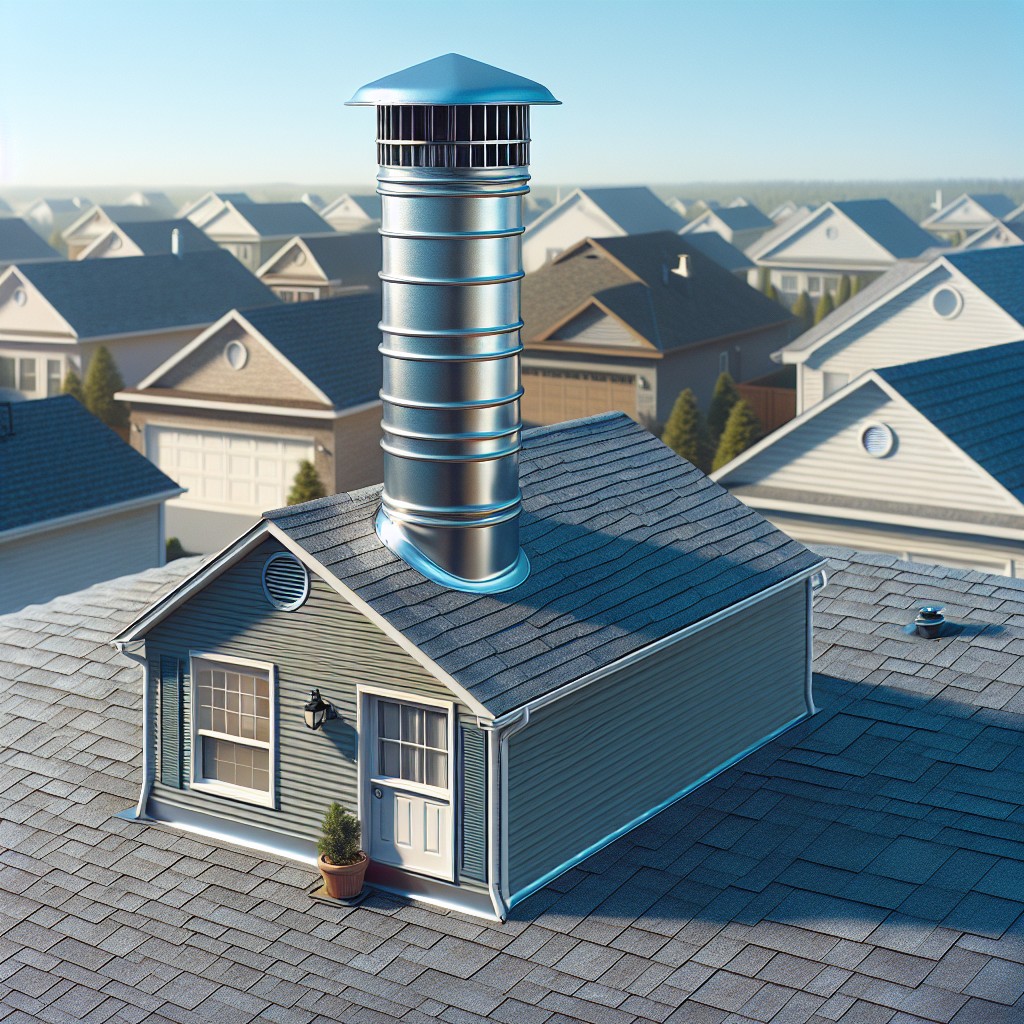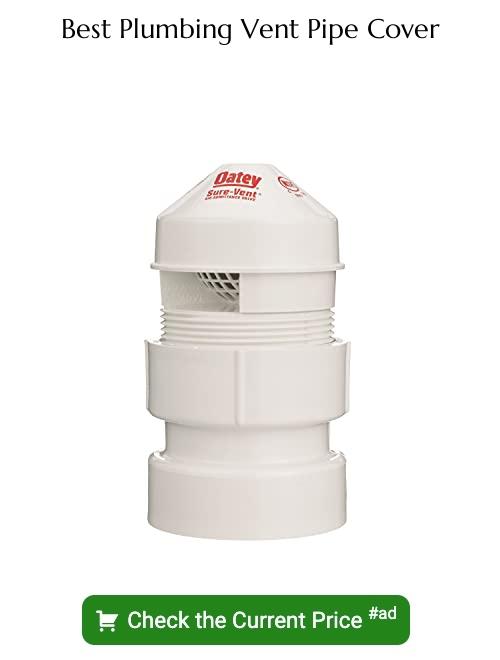Last updated on
You may have wondered why there’s a water pipe protruding from your roof, because understanding its function can solve many household’s issues.
Key takeaways:
- Plumbing vents regulate air pressure in the plumbing system.
- Vents prevent sewer gases from entering living spaces.
- Vents allow waste to be carried out effectively without siphoning water.
- Clogged vents can cause slow drainage and gurgling sounds.
- Addressing a clogged vent requires visual inspection and careful removal.
The Black Pipe Sticking Out of Your Roof: The Plumbing Vent

Commonly visible on most residential rooftops is a black pipe, known as the plumbing vent, which extends through the roof surface. This fixture is an essential part of your home’s plumbing system, performing several crucial functions:
- Regulation of Air Pressure: Plumbing vents maintain neutral air pressure in the plumbing system, facilitating the smooth flow of water and waste through drain pipes.
- Prevention of Sewer Gases: Vents act as an outlet for sewer gases, channeling them out above the roof line, thereby preventing them from entering the living spaces.
- Allowance for Waste to Exit: By equalizing pressure, these vents allow waste to be carried out of the house effectively without the risk of siphoning water from P-traps, which could lead to the release of gases indoors.
Understanding that the black pipe is more than just an odd protrusion but a vital component of your household infrastructure adds to a better comprehension of your home’s functional integrity.
What Does the Plumbing Vent Do?

A plumbing vent, formally known as a vent stack, helps regulate the air pressure in your home’s plumbing system. It facilitates the flow of waste water and sewage by allowing fresh air into the system, which helps to maintain proper drainage. Without this crucial ventilation, water and waste could not move efficiently through the pipes.
The vent also serves as an escape route for sewer gases. These gases, which accumulate as a natural byproduct of waste, are safely released above the roofline, thus preventing them from becoming a health hazard or producing unpleasant odors inside the home. Additionally, the plumbing vent ensures that traps, sections of pipe where water consistently sits to block sewer gases from rising into the home, maintain enough water to function effectively.
Can the Plumbing Vent Clog?
Certainly, plumbing vents can become clogged, which typically occurs due to external debris or animal nests obstructing the flow. These blockages can interfere with the proper regulation of air pressure in the plumbing system.
Leaves, sticks, and even tennis balls can find their way into the vent opening, especially if it’s not properly covered or screened. In colder climates, ice or snow can also accumulate and cause obstructions. On top of that, birds, squirrels, or insects might choose the vent pipe as a nesting spot, leading to further blockages.
Regular inspection and maintenance are essential to prevent clogging and ensure the plumbing system operates efficiently.
Signs of a Clogged Vent
Recognizing a clogged vent is crucial for timely intervention. Slow drainage throughout your house can indicate a blockage, as the lack of air circulation within pipes hampers water flow.
Gurgling sounds after flushing the toilet offer a telltale sign, often resulting from trapped air trying to escape through water in the trap.
Additionally, watch for unpleasant odors resembling rotten eggs, which might waft through your home as sewer gases find alternative paths due to a blocked vent.
Lastly, observe any bubbling in your toilet or drains, pointing to irregular air pressure in the system.
Timely detection allows for prompt solutions to prevent further complications.
Dealing With a Clogged Vent
Addressing a clogged plumbing vent requires a careful approach to ensure the issue is resolved without causing additional problems:
1. Safety First: Because resolving a clog often involves accessing the roof, safety must be your top priority. Use a sturdy ladder, wear non-slip shoes, and consider a safety harness.
2. Inspection: Begin by visually inspecting the vent for any obvious obstructions, such as nests, leaves, or debris. If the blockage is within reach, use gloves to remove the material.
3. Auger Use: For deeper clogs, a plumber’s snake or auger can be fed into the vent pipe to dislodge debris. This task should be done with caution to avoid damaging the pipes.
4. Water Flush: After removing the blockage, flush the vent with water to ensure it’s clear. Water should flow freely without any backup.
5. Professional Help: If these steps do not clear the clog or if you are not comfortable performing them, enlist the services of a licensed plumber. Qualified professionals have the expertise and equipment to handle complex issues.
Regular maintenance can prevent future clogs in your plumbing vent. This includes routine inspections and keeping the area clear of overhanging branches and leaves that could fall into the vent.
What Causes a Plumbing Vent Pipe Leak in Your Roof
Various factors can lead to leaks in your roof’s plumbing vent pipe:
- Age: Over time, sealing materials can degrade, leading to leaks around the base of the vent.
- Weather Damage: Harsh weather conditions, like heavy rains, snow, and high winds, can damage the vent or its seals.
- Improper Installation: If the vent pipe was not correctly fitted or sealed during installation, it could be prone to leaks.
- Sealant Failure: The sealant around the vent can fail due to temperature changes or exposure to ultraviolet light, causing gaps that let water in.
- Physical Damage: Any physical damage to the pipe, such as from falling branches or other impacts, can create openings for water to enter.
- Roof Movement: Natural expansion and contraction of the roof materials can cause the vent boot to loosen or crack over time, allowing water penetration.
Addressing these issues promptly can help prevent more extensive damage to your roof and underlying structures.
How to Determine If Your Roof’s Plumbing Vent Pipe Is Leaking
Identifying a leak in a plumbing vent pipe on your roof requires some detective work. Look for water stains on the ceiling, especially after a rainstorm, as they can signal a leak. If the stains are directly below where the vent pipe goes through the roof, this is a strong indicator.
Additionally, inspect the rubber boot surrounding the vent pipe. Cracks or deterioration in this area can allow water to seep through. Checking in the attic can also be revealing; moisture or mold around the vent pipe’s penetration point is a telltale sign of leaking.
If you’re comfortable doing so, carefully climbing onto the roof and visually examining the vent pipe for damage or gaps where it meets the roof surface can confirm suspicions of a leak. Always prioritize safety and consider hiring a professional if a roof inspection is outside your comfort zone.
The Importance of Proper Installation and Quality Products
Proper installation ensures the longevity and functionality of the plumbing vent pipe protruding from your roof. Incorrectly installed vents can lead to water intrusion, which may compromise your roof’s integrity and the overall health of your plumbing system. Additionally, high-quality materials resist the damaging effects of ultraviolet light, temperature fluctuations, and extreme weather, preserving the vent’s structural soundness.
Key considerations for installation and product choice include:
- Sealing and Flashing: A critical step is ensuring the vent pipe is sealed correctly. The use of durable flashing materials helps prevent leaks where the pipe exits the roof.
- Material Compatibility: Choosing vent pipe materials compatible with your roof type helps prevent chemical reactions that can lead to corrosion and leaks.
- Height and Location: The pipe should extend to an adequate height above the roof, as per local building codes, to ensure effective venting and prevent snow or debris from obstructing the opening.
- Code Compliance: Adhering to building codes is essential not just for legal compliance but for the safety and efficiency of your home’s plumbing system.
Investing in both proper installation and quality products mitigates the need for costly repairs and ensures the system ventilates your home correctly.
FAQ
What is the pipe coming out of my roof for?
The pipe protruding from your roof is a vent pipe that regulates air pressure in your plumbing pipes, permits sewer gases to escape outside, and introduces oxygen to break down waste aerobically in the sewage pipes.
What are the pipes that come out of the top of the roof?
The pipes protruding from the top of the roof are known as roof vents, crucial for the proper functioning of household plumbing systems.
Why is water coming out of my vent pipe on my roof?
Water could be coming out of your vent pipe on the roof due to damages to the plumbing vent pipe collar or flashing, which often happens following exposure to adverse weather conditions or impact from debris.
What is roof water pipe called?
The water pipe protruding from the top of a roof is known as a plumbing vent.
How can one effectively maintain the condition of a roof’s vent pipe?
To effectively maintain the condition of a roof’s vent pipe, regular inspections and cleaning should be performed, combined with sealing any detected cracks or leaks promptly.
What could be potential issues if water leaks from the roof’s vent pipe?
Water leaks from a roof’s vent pipe can cause interior water damage, mold growth, structural weaknesses, and increased energy costs.
What are the best practices for replacing a damaged roof water pipe?
The best practices for replacing a damaged roof water pipe include thorough inspection, acquiring the necessary tools and materials, removing the damaged pipe, installing the new pipe correctly, and ensuring proper sealing to prevent leakages.





